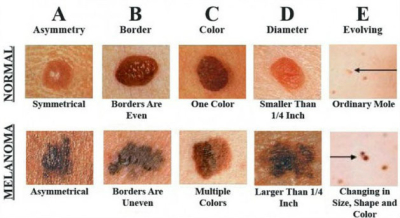
In the run up to the summer, everyone needs to be mindful of the risk of developing melanomas from the sun’s harmful UV rays. Melanoma is the most serious form of skin cancer; according to Melanoma UK, over 12,500 cases were diagnosed last year with 2,250 deaths. Scarily, and despite the raised awareness, rates have increased over the last 30 years.
If you're concerned about a mole or an area of skin, your first port of call needs to be your GP. They will assess your concern, and may then refer you to a dermatologist for a second opinion; this can take approximately two weeks for an urgent referral.
You don't have to go to your NHS GP for a mole check. If you'd like to routinely get your moles checked or you've noticed a change in your skin, you can see a dermatologist privately. The benefit of seeing a dermatologist, or consultant dermatologist (i.e. senior doctor), is they are specialists in all aspects of skin and skin disease, with a huge amount of experience diagnosing and treating skin concerns, including skin cancer.
It's important to remember that skin cancer presents in other forms, not just abnormal moles. It can also be lumps and scaly patches. So if you are concerned about any aspect of your skin health, seek professional advice.
Prevention
The Skin to Love Clinic's consultant dermatologist, Dr Crichlow, gives advice on what to look out for and what to do (and not to do!) in order to keep your skin as healthy as possible:
“When it comes to moles, bear in mind the ABCDE rule to help you look for signs of melanoma [explained below]. It's always a good habit to have a yearly mole check with your dermatologist where they'll give you an all-over assessment; this is especially important if you, or any of your close family, have a previous history of skin cancer. It's hugely important to wear a daily sun cream with a 30 to 50 SPF and when on holiday, always wear a sun hat and try to avoid being in the sun between 11am and 3pm”.
Finally, Su, the nurse independent prescriber at The Skin to Love Clinic in St Albans, has this helpful tip: “Take photos of your moles every few months, especially on your back where you don’t see them regularly, to help you track any changes”.
ABCDE rule to check for possible melanomas
A A-symmetry: If you were to draw a line through the mole, the two halves do not match.
B Borders: Irregular, uneven.
C Colour: A variety of colours within a mole can be a warning sign; different shades of brown, tan or black could appear. A melanoma may also become blue, red or blue.
D Diameter: Melanomas are usually larger than 6mm in diameter.
E Evolution: Be on the lookout for moles changing. This can be any type of change - size, colour, shape, becoming raised or flatter, or any new trait or symptom such as crusting, bleeding or itching.
If you would like to arrange a private appointment to see Dr Crichlow, please call The Skin to Love Clinic on 01727 837429.

As the owner of thebestof St Albans and Harpenden my mission is to help local independently owned businesses to grow and community groups, charities, local sports clubs, societies to thrive. If you know...
The following Cookies are used on this Site. Users who allow all the Cookies will enjoy the best experience and all functionality on the Site will be available to you.
You can choose to disable any of the Cookies by un-ticking the box below but if you do so your experience with the Site is likely to be diminished.
In order to interact with this site.
To help us to measure how users interact with content and pages on the Site so we can make
things better.
To show content from Google Maps.
To show content from YouTube.
To show content from Vimeo.
To share content across multiple platforms.
To view and book events.
To show user avatars and twitter feeds.
To show content from TourMkr.
To interact with Facebook.
To show content from WalkInto.